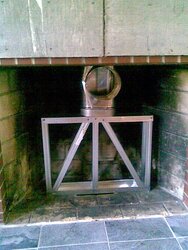After getting the smoke box clean, I am trying to anticipate any install issues. I believe I have settled on the Saf-T vent solid liner with insulation as the chimney is pretty much a straight drop with a 7" shift in the smoke box. I think I have enough room that 2 - 15 degree elbow with a 24" section will accomidate the shift.
With the solid liner, how does it handle expansion? Do the pop rivits survive the frequent heating cooling? Is there any noise associated with fastners loosing up and the expansion?
The chimney is an external masonary with two flues, the second being the oil burner. The woodstove flue is current a clay flue which raises 8" above the oil burner flue. Should I keep this flue higher or do I cut it down to the crown? When installing the top plate, the instructions say to secure it with silicone. Is this really sufficient to keep the top plate in position and not open the chimney to the elements? Why not use tapcons and have the ability to remove for maintainance and inspection?
Thanks in advance for any feedback.
With the solid liner, how does it handle expansion? Do the pop rivits survive the frequent heating cooling? Is there any noise associated with fastners loosing up and the expansion?
The chimney is an external masonary with two flues, the second being the oil burner. The woodstove flue is current a clay flue which raises 8" above the oil burner flue. Should I keep this flue higher or do I cut it down to the crown? When installing the top plate, the instructions say to secure it with silicone. Is this really sufficient to keep the top plate in position and not open the chimney to the elements? Why not use tapcons and have the ability to remove for maintainance and inspection?
Thanks in advance for any feedback.


